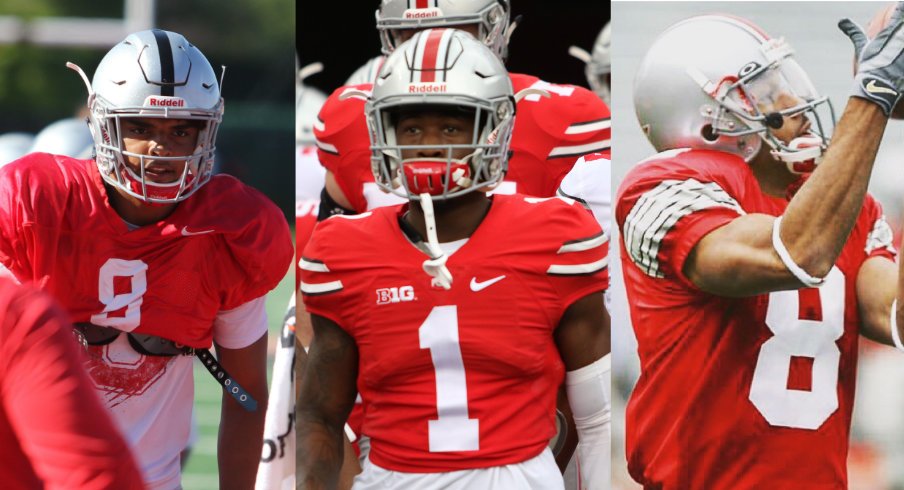Johnnie Dixon and Trevon Grimes are healthy. For both Buckeye receivers, that's been a long time coming.
Dixon has been plagued with knee injuries throughout his Ohio State career sidelining him more than he's been healthy. Grimes had the first major setback of his young career when he tore his ACL last October, sidelining him until recently.
Just a few weeks until the start of the 2017 season, the pair of receivers is in the midst of fall camp, practicing in the late-summer heat, battling talented teammates for positions on the depth chart and preparing for an away opener – the easy part after all they've been through, said former Ohio State wide receiver Drew Carter.
Carter is all too familiar with the rehabilitation process after a knee injury as he suffered four different ACL tears throughout his playing career.
After redshirting his first season in Columbus, Carter played sparingly his second, but he tore his ACL causing him to miss the entirety of his sophomore season. He then played the entire 2002 season, winning a national championship with his team, before tearing his other ACL midway through his senior season.
"Rehab is one of the loneliest times you can have in your career."– Drew Carter
Despite the extent of his injuries, Carter remained completely confident he would make a full recovery both times he suffered the injury.
"There was no doubt in my mind," Carter said. "Not even an inkling."
Though, rehabilitation proved to be a slow, isolating process, Carter admitted. He said it was always difficult to be sitting on a training table alone instead of practicing with his teammates, and that there was plenty of self-doubt and sleepless nights.
"Rehab is one of the loneliest times you can have in your career," he said.
But Carter said one thing got him through the rehab: his mentality.
"You have to make the choice; you have to decided," Carter said. "Not only am I going to be a normal human again, I'm going to be an elite athlete."
That mindset is what fueled him throughout his recovery process, Carter said. As an athlete used to physical challenges, he simply shifted his focus – rehab was now the physical challenge. Instead of the weight room, he did physical therapy, with the end result remaining the same – get his body ready to compete.
"You have to fall in love with the process," Carter said.
And he was right, he did make a full recovery – more than once.
After running a 4.27-second 40-yard dash in front of pro scouts after his junior season, Carter knew he had to showcase some speed during Ohio State's pro day if he wanted to make an NFL roster. After just four months of rehab, Carter ran a 4.4, and a few months later, he was drafted in the fifth round by the Carolina Panthers.
That recovery was short-lived, though. On his first day of rookie minicamp, Carter tore his ACL once again, just one play after hauling in a deep reception and celebrating his return to football with his teammates.
With the same mentality as before, Carter fought through rehab once again, and he succeeded once again. Carter made the team during the 2005 season, and in the Panthers three postseason games that season, he had 4 receptions for 131 yards and a touchdown, still owning a franchise record for most yards per catch in a single postseason with 32.75.
"You have to make the choice; you have to decided. Not only am I going to be a normal human again, I'm going to be an elite athlete."– Drew Carter
Carter admitted he thought his NFL career was over before it truly began when he tore his ACL during rookie minicamp – "I was thinking 'that was cool, I got to see the inside of an NFL locker room,'" he said – but a little over a year later, he was catching a touchdown pass in the NFC Championship Game.
"What a difference a year makes," Carter said.
Carter's NFL career ended just a few years later when he tore his ACL for a fourth time during a 2008 preseason game in Oakland, but the triumph was already there. Carter overcame three ACL tears and still managed to catch 71 passes for 977 yards and eight touchdowns in the NFL.
That should serve as an inspiration for Dixon and Grimes – no matter how long, lonely and difficult the rehab process was, you never know what sort of success awaits you on the other side. That's been Carter's mentality throughout his multiple rehabs and he's stuck to it even after his football career as he pursues a career in acting.
"I'm going to do the work," Carter said. "I don't know what's going to happen after that."
Right now, Dixon and Grimes are somewhere in between the lonely training table and that glorious, game-breaking touchdown catch. They're healthy, but they still have plenty of work to do. Just a few weeks until the start of the season, they now must prove they belong on the field and earn their spot on the depth chart – because it sure didn't wait for them while they were injured.
"The thing about it is, [the coaches] have to put guys on the field to win a game," Carter said. "I'm at the bottom of the depth chart. There are five guys in front of me."
But when it comes down to it, that's what these players want. After months of being physically unable to play, they're itching to play again, to compete, and to show they have every bit of the ability they had before – maybe even more.
After the grueling rehabilitation process, they're just happy to be healthy and are more than ready for the next set of challenges. Because after all they've been through, this is the easy part.
As Carter put it: "I'm healthy again. Game On."


